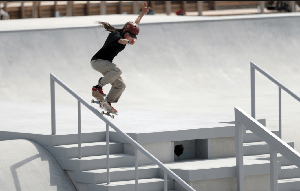Basic Rules of Skateboarding for Beginners
Without doubt, skateboarders have developed a recreational activity into a common action sport enjoyed by millions of individuals worldwide.
Among its key successes are being able to ride the board at high speeds while performing a variety of gravity-defying tricks with it.
Moreover, despite having its street culture roots firmly fixed in sidewalk surfing, skateboarding has now been added to the Olympics.
Fun Fact: Skateboarding is illegal in some places. For example, it is banned and classified as a ‘public menace’ in Norway.
What is the Aim of Skateboarding?
The primary objective for people who skateboard is executing an array of advanced and complicated tricks on a half-pipe (e.g. a U-shaped platform or ramp)
As a rule, riders take turns completing a predetermined route without touching the ground and without using any supports for balance. They try to perform flips, mid-air spins, and ollies (jumps).
It is a unique sport that gives its participants an opportunity to represent themselves in a way that matches their character and identity.
Skateboarding originated as a form of ‘sidewalk surfing’ in the United States of America around the beginning of the 1950s. Nowadays, it has evolved into almost any purpose you want it to be, including:
- An art form
- A career (e.g. as a professional skateboarder)
- A method or means of transportation (e.g. similar to hoverboards and powered transporters)
- An entertainment industry job
- A fun, recreational activity (despite being considered as one of the dangerous extreme and weird sports by some)
Note: The main section contains more information about sports rules and regulations listed alphabetically from A to Z.
Equipment Used by Skateboarders
Skateboard equipment consists of two sets of small, metal, wheels attached to the underside of a short, narrow board (close to each end). Despite being a ‘cool’ activity, injuries can – and do – happen!
So, aside from specially designed and ‘predictable’ course designs as used in the Tokyo Olympic Games, riders should always skate in a safe place.
Before young children and beginners head outside to skate, some of the protective gear you should be wearing includes:
- Non-slip, closed-toe footwear.
- Elbow and knee pads.
- Wrist guards to protect the carpus when falling.
- Eye goggles (or shatterproof glasses)
- A proper-fitting helmet (e.g. a skateboarding helmet or a multi-sport head protector).

Note: Some manufacturers (many starting as furniture designers) used fiberglass to produce board decks in the 1970s. Modern skateboard decks are much stronger and more durable, made with hard maple veneers.
Skateboarding Rules Olympics 2021
Essence of the Sport
The two disciplines held in the programme for the skateboarding events are ‘street’ and ‘park’ at the 2020 Tokyo Olympics.
Competitions for skateboarders include men’s and women’s events. All athletes will be able to demonstrate their skills in a celebratory atmosphere.
Two Course Designs
The courses chosen for Tokyo 2020 have strong connections to the designs and experiences from several world championship skateboarding events.
Despite being much larger than those used in previous elite competitions, they will be small enough for athletes to use regular obstacles during a typical run.
The designs used for the two courses pay strong attention to ‘equality’ and gender. Thus, regular and any goofy stance skateboarders will have opportunities to excel.
Street (Men/Women)
The ‘street-like’ competition takes place on a straight course that also features stairs (with handrails), benches, curbs, slopes, and walls.
Skateboarders get a chance to perform by themselves using all sections of the course to show off their skills and tricks. Judging will take three separate factors into account before awarding a final mark, being:
- Degree of difficulty
- Execution
- Composition of the moves
Note: Most skateboarders will try to perform an ollie with a flipping of the deck in various ways under their feet. The skill should end by bringing the board back to their feet before making a safe, secure, landing. Some of the most experienced skaters will add a variation by rotating their body at the same time.
Park (Men/Women)
The Tokyo Olympics used a hollowed-out course for ‘park’ competitions. It featured a series of complex curves – shaped similar to dome-shaped bowls and large dishes.
Major attractions included immense heights achieved when boarders climbed curves at speed, while performing amazing mid-air tricks.
Note: Rotating or flipping the deck mid-air increases the difficulty and originality of the tricks. Other advanced maneuvers include variations of the grinds, stalls (balancing), and slides (e.g. on the ramp lip).
Sports Articles and Help Guides
- Hoverboard laws in the United Kingdom.
- Parkour explained for beginners.
- Ultimate Frisbee rules and regulations.
Note: This short video clip explains some of the ‘unwritten’ rules of skateboarding with great examples of skaters doing their thing!

